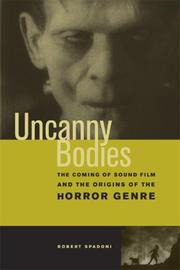| Listing 1 - 2 of 2 |
Sort by
|

ISBN: 9780520251229 9780520251212 0520251210 0520251229 128138562X 0520940709 9786611385620 1435653653 9780520940703 6611385622 9781435653658 9781281385628 Year: 2007 Publisher: Berkeley : University of California Press,
Abstract | Keywords | Export | Availability | Bookmark
 Loading...
Loading...Choose an application
- Reference Manager
- EndNote
- RefWorks (Direct export to RefWorks)
In 1931 Universal Pictures released Dracula and Frankenstein, two films that inaugurated the horror genre in Hollywood cinema. These films appeared directly on the heels of Hollywood's transition to sound film. Uncanny Bodies argues that the coming of sound inspired more in these massively influential horror movies than screams, creaking doors, and howling wolves. A close examination of the historical reception of films of the transition period reveals that sound films could seem to their earliest viewers unreal and ghostly. By comparing this audience impression to the first sound horror films, Robert Spadoni makes a case for understanding film viewing as a force that can powerfully shape both the minutest aspects of individual films and the broadest sweep of film production trends, and for seeing aftereffects of the temporary weirdness of sound film deeply etched in the basic character of one of our most enduring film genres.
Horror films --- Sound motion pictures --- Films d'horreur --- Films sonores --- History and criticism. --- Histoire et critique --- 82:791.43 --- Literatuur en film --- Horror films - United States - History and criticism. --- Horror films. --- Sound motion pictures - History and criticism. --- Film --- Music, Dance, Drama & Film --- History and criticism --- 82:791.43 Literatuur en film --- Moving-pictures, Talking --- Talkies --- Talking motion pictures --- Motion pictures --- 20th century american culture. --- 20th century american film history. --- american culture. --- american film history. --- american movie history. --- audience reception. --- cinema. --- classic horror cinema. --- dark. --- dracula. --- early sound film. --- film studies. --- filmmaking. --- frankenstein. --- hollywood cinema. --- horror genre. --- horror movies. --- intense. --- modality. --- movie studies. --- sound film. --- svengali. --- the hollywood review of 1929. --- uncanny theater. --- united states of america. --- universal pictures. --- vampires. --- ventriloquism.
Book
ISBN: 9781479803118 9781479803132 9781479803101 1479803103 1479803111 9781479803125 Year: 2022 Publisher: New York New York University Press
Abstract | Keywords | Export | Availability | Bookmark
 Loading...
Loading...Choose an application
- Reference Manager
- EndNote
- RefWorks (Direct export to RefWorks)
"Throughout history, the religious imagination has attempted to control nothing so much as our bodies: what they are and what they mean; what we do with them, with whom, and under what circumstances; how they may be displayed-or, more commonly, how they must be hidden. Religious belief and mandate affect how our bodies are used in ritual practice, as well as how we use them to identify and marginalize threatening religious Others. This book examines how horror culture treats religious bodies that have stepped (or been pushed) out of their 'proper' place. Unlike most books on religion and horror, This book explores the dark spaces where sex, sexual representation, and the sexual body come together with religious belief and scary stories. Because these intersections of sex, horror, and the religious imagination force us to question the nature of consensus reality, supernatural horror, especially as it concerns the body, often shows us the religious imagination at work in real time. It is important to note that the discussion in this book is not limited either to horror cinema or to popular fiction, but considers a wide range of material, including literary horror, weird fiction, graphic storytelling, visual arts, participative culture, and aspects of real-world religious fear. It is less concerned with horror as a genre (which is mainly a function of marketing) and more with the horror mode, a way of storytelling that finds expression across a number of genres, a variety of media, and even blurs the boundary between fiction and non-fiction. This expanded focus not only deepens the pool of potential examples, but invites a much broader readership in for a swim"--
Horror. --- Human body --- Popular culture --- Religious aspects. --- Alien invasion. --- Ambiguity. --- Anthropology. --- Anti-Catholic nativism. --- Anti-Pagan activism. --- B movies. --- Censorship. --- Clive Barker. --- Clovis Trouille. --- Cosmic horror. --- Cosmic indifference. --- Cthulhu Mythos. --- Devil. --- Dracula. --- Edward Lee. --- Enigma. --- Evolutionary psychology. --- Exploitation. --- Fear. --- Graphic novels. --- H. P. Lovecraft. --- Horror genre. --- Horror mode. --- Human sacrifice. --- Interpretive drift. --- King Kong. --- Legion of Decency. --- Lustmord. --- Margaret Brundage. --- Maria Monk. --- Marquis de Sade. --- Matthew Lewis. --- Monstering. --- Monstrous body. --- Morality. --- Motion Picture Association of America. --- Motion Picture Production Code. --- Nudity. --- Numinous. --- Nun fetish. --- Nunsploitation. --- Pulp fiction. --- Queer horror. --- Realization. --- Religion. --- Religious Imagination. --- Religious imagination. --- Religious questions. --- Riddle. --- Ritual rarity. --- Roger Corman. --- Rudolf Otto. --- Sadeian horror. --- Sex. --- Sexual bodies. --- Sexualized advertising. --- Sigmund Freud. --- Skepticism. --- Spatter horror. --- Stephen King. --- Tanya Luhrmann. --- The Exorcist. --- The Wicker Man. --- The Witch. --- Thomas Rowlandson. --- Weird Tales. --- Witchcraft. --- Wrath James White. --- Sex --- Horror --- Religious aspects
| Listing 1 - 2 of 2 |
Sort by
|

 Search
Search Feedback
Feedback About UniCat
About UniCat  Help
Help News
News